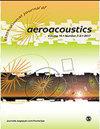Is an elliptic jet quieter than a round jet?
IF 1.3
4区 工程技术
Q3 ACOUSTICS
引用次数: 0
Abstract
Non-axisymmetric geometries, mainly elliptic and rectangular, have been proposed for the reduction of jet noise vis-à-vis round nozzles. Most of the studies of these nozzles are from unheated jets and are restricted to nozzles of very small size. Furthermore, all of them have been carried out at static conditions, thereby rendering their value to insignificance for practical applications. All engines in service with long ducts and a confluent nozzle incorporate an internal lobed mixer. The aeroacoustic characteristics of an elliptic compound nozzle that represents the geometry of an existing low bypass ratio (BPR) turbofan engine, is investigated at 1/7th scale in this study. Typical engine cycle conditions are chosen; data are acquired statically and in the presence of a flight stream. The aspect ratio of the nozzle is 2.0; higher aspect ratios are not suitable for engine applications. The results are compared with a round compound nozzle with the same internal geometry, so as to assess the acoustic benefit, if any, of the elliptic nozzle. Both a simple internal splitter and an in-service lobed mixer have been considered. The elliptic nozzle introduces azimuthal asymmetry even for an unheated jet; the magnitude of azimuthal variation becomes pronounced for heated jets. Typically, the lowest level of noise is observed towards the narrow side of the elliptic nozzle (ϕ = 0°); the noise level gradually increases and reaches a maximum towards the broader side (ϕ = 90°). Though there are some superficial similarities between the elliptic and beveled nozzles, it is shown that the noise characteristics are very different. A systematic study is carried out, with step-by-step build up to realistic geometry, with forward flight. A large noise reduction of ∼3 to ∼4 EPNdB is observed for the splitter nozzle under static conditions. The introduction of a realistic lobed mixer reduces this benefit to close to zero. Finally, there is a noise increase at all azimuthal angles with forward flight. Therefore, the elliptic nozzle does not provide any EPNL benefit for actual nozzle geometry and consequently does not constitute a viable design for noise reduction. The importance of evaluating noise reduction concepts using appropriate geometry and under realistic forward flight conditions is emphasized once again.椭圆射流比圆形射流更安静吗?
非轴对称的几何形状,主要是椭圆和矩形,已被提出用于降低喷射噪声-à-vis圆形喷嘴。大多数对这些喷嘴的研究都是从未加热的射流中进行的,并且仅限于非常小尺寸的喷嘴。此外,所有这些都是在静态条件下进行的,因此对实际应用的价值微不足道。所有使用中的长管道和合流喷嘴的发动机都包含一个内部叶状混合器。本文在1/7尺度下研究了代表现有低涵道比(BPR)涡扇发动机几何形状的椭圆复合喷管的气动声学特性。选择典型的发动机循环工况;数据是静态地在飞行流的存在下获得的。喷嘴长径比为2.0;高宽高比不适合发动机应用。将结果与具有相同内部几何形状的圆形复合喷嘴进行了比较,以评估椭圆喷嘴是否有声学效益。考虑了简单的内部分离器和在役的分叶混合器。椭圆喷嘴即使在未加热的射流中也引入了方位不对称性;对于加热射流,方位变化的幅度变得明显。通常情况下,最低水平的噪声被观察到朝着椭圆形喷嘴的窄边(ϕ = 0°);噪声水平逐渐增加,并在更宽的一侧(ϕ = 90°)达到最大值。椭圆型和斜面型喷嘴表面上有一些相似之处,但其噪声特性却有很大的不同。进行了系统的研究,逐步建立到现实的几何,与向前飞行。在静态条件下,分离器喷嘴的降噪幅度可达~ 3 ~ ~ 4 EPNdB。现实的分叶混合器的引入将这种好处减少到接近于零。最后,在前飞的各个方位角上都有噪声的增加。因此,对于实际的喷嘴几何形状,椭圆喷嘴不能提供任何EPNL优势,因此不能构成一种可行的降噪设计。再次强调了使用适当的几何形状和在现实的前飞条件下评估降噪概念的重要性。
本文章由计算机程序翻译,如有差异,请以英文原文为准。
求助全文
约1分钟内获得全文
求助全文
来源期刊

International Journal of Aeroacoustics
ACOUSTICS-ENGINEERING, AEROSPACE
CiteScore
2.10
自引率
10.00%
发文量
38
审稿时长
>12 weeks
期刊介绍:
International Journal of Aeroacoustics is a peer-reviewed journal publishing developments in all areas of fundamental and applied aeroacoustics. Fundamental topics include advances in understanding aeroacoustics phenomena; applied topics include all aspects of civil and military aircraft, automobile and high speed train aeroacoustics, and the impact of acoustics on structures. As well as original contributions, state of the art reviews and surveys will be published.
Subtopics include, among others, jet mixing noise; screech tones; broadband shock associated noise and methods for suppression; the near-ground acoustic environment of Short Take-Off and Vertical Landing (STOVL) aircraft; weapons bay aeroacoustics, cavity acoustics, closed-loop feedback control of aeroacoustic phenomena; computational aeroacoustics including high fidelity numerical simulations, and analytical acoustics.
 求助内容:
求助内容: 应助结果提醒方式:
应助结果提醒方式:


